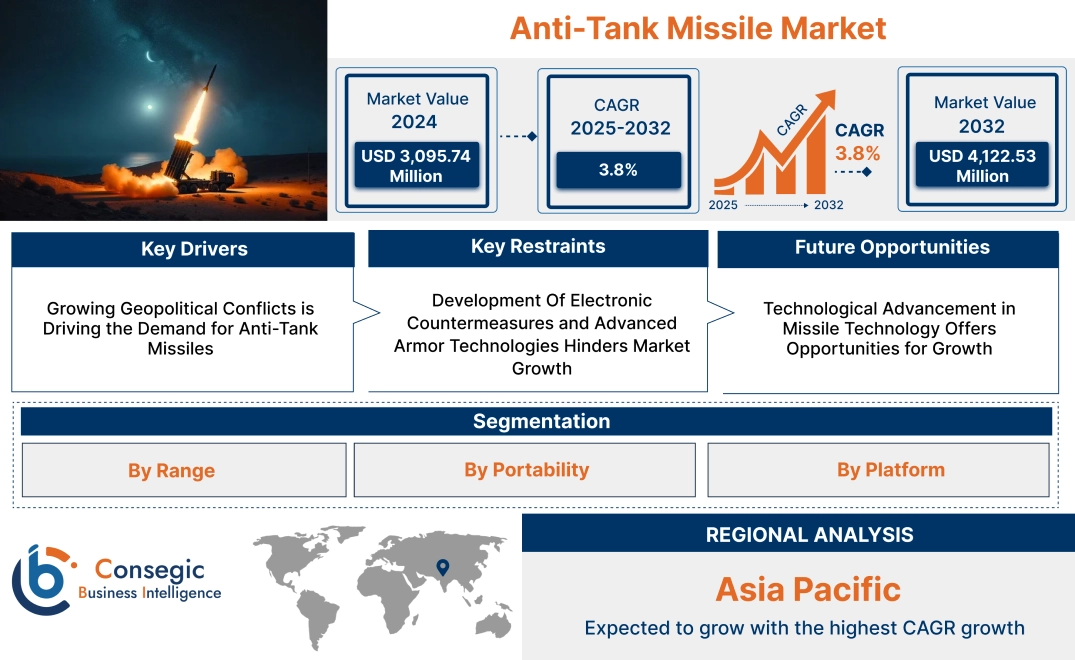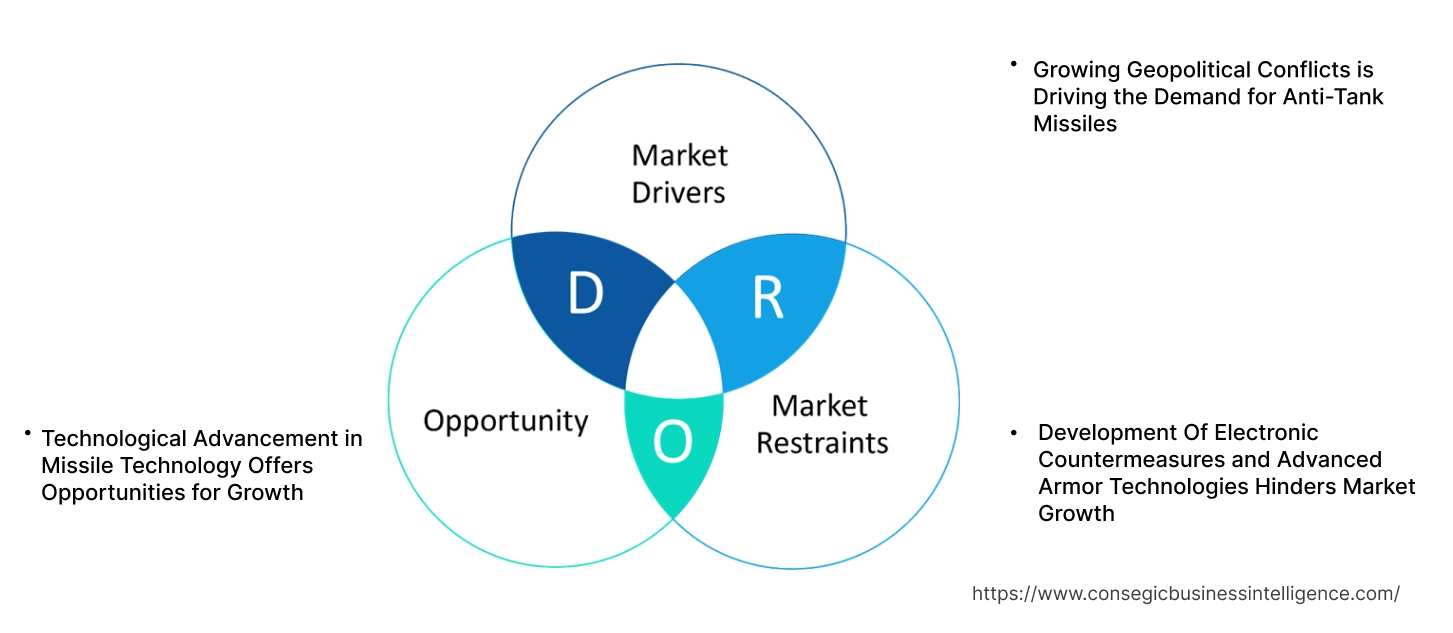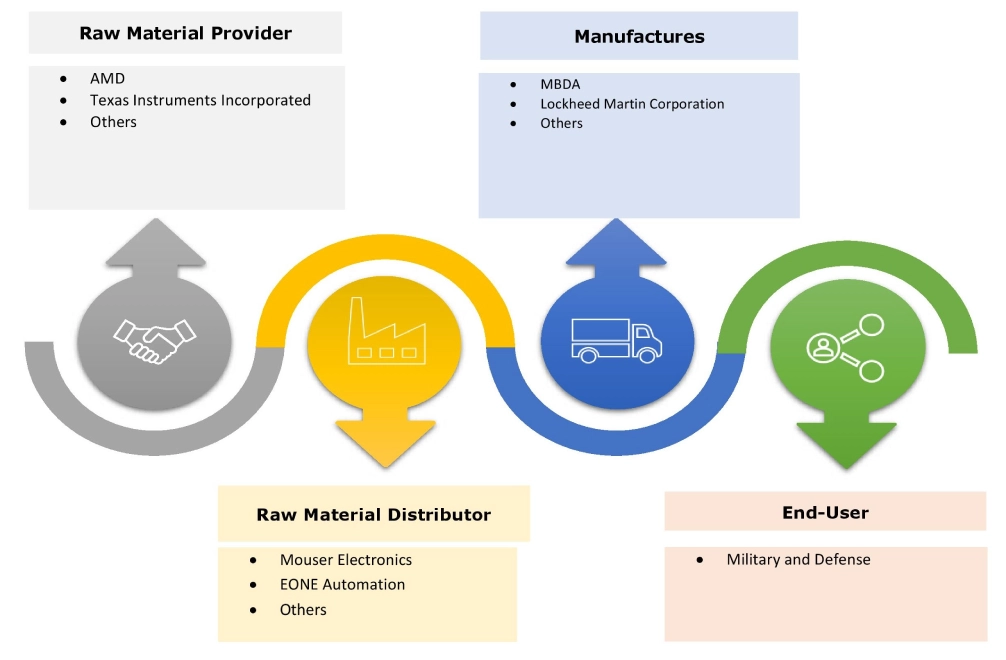- Summary
- Table Of Content
- Methodology
Anti-Tank Missile Market Size:
Anti-Tank Missile Market is estimated to reach over USD 4,122.53 Million by 2032 from a value of USD 3,095.74 Million in 2024 and is projected to grow by USD 3,154.74 Million in 2025, growing at a CAGR of 3.8% from 2025 to 2032.
Anti-Tank Missile Market Scope & Overview:
Anti-tank missile is a guided missile that is designed and developed to destroy or damage heavily armored military vehicles or tanks. The missiles have completely revolutionized warfare by giving infantry soldiers the ability to effectively engage and destroy tanks. The market is driven by several factors including increasing defense budgets, rising geopolitical tensions, and technological advancements. Further, countries around the world are prioritizing military modernization and enhancing defense capabilities which in turn increases the allocation of resources towards advanced weaponry systems, including anti-tank missiles. Furthermore, technological advancements such as improved guidance systems and the development of long-range missiles are also driving the anti-tank missile market growth.
Key Drivers:
Growing Geopolitical Conflicts is Driving the Demand for Anti-Tank Missiles
The growing geopolitical tensions and conflicts across the globe are significant drivers for the demand for systems. Conflicts occur over a wide range of issues including territorial disputes, resource allocation, ideological differences, and cultural clashes, among others. One such conflict is the Russia-Ukraine war which has encouraged the countries in the European Union to invest more in defense expenditure.
- For instance, according to the Coordinated Annual Review on Defense (CARD) report, published by the European Defence Agency in 2023, European defense expenditure witnessed a 10% year-on-year increase, reaching a record high of USD 301.95 billion. Further, defense spending in the European Union is projected to reach USD 352.81 billion in 2024 which in turn is expected to drive the demand for the system.
Thus, ongoing conflicts and the threat of potential future confrontations are fueling the demand for the market.
Key Restraints:
Development Of Electronic Countermeasures and Advanced Armor Technologies Hinders Market Growth
The development of sophisticated electronic countermeasures (ECM) and advanced armor technologies poses a significant challenge to the anti-tank missile market expansion. ECM systems, such as electronic jammers disrupt the guidance systems of the market, making them ineffective. Similarly, advancements in armor technology, including the development of composite materials and reactive armor, enhance the survivability of armored vehicles against missile attacks. These countermeasures necessitate continuous innovation in missile design, driving the need for more sophisticated guidance systems and warheads to maintain effectiveness on the battlefield.
Thus, the development of sophisticated electronic countermeasures (ECM) and advanced armor technologies is hindering the anti-tank missile market expansion.
Future Opportunities :
Technological Advancement in Missile Technology Offers Opportunities for Growth
Technological advancements in missile technology offer significant prospects for anti-tank missile market opportunities. The continuous development of more sophisticated guidance systems, warheads, and propulsion systems enhances the lethality, precision, and range of systems. These advancements not only improve the effectiveness of existing systems but also create the need for newer, more capable weapons. The integration of artificial intelligence and machine learning into missile systems, for instance, promises to revolutionize target acquisition, tracking, and engagement, further expanding their capabilities and market potential. As military forces strive to maintain technological superiority, the need for these innovative systems is expected to drive the anti-tank missile market opportunity.
- For instance, ROKETSAN, a key player in the defense industry manufactures a Long-Range Anti-Tank Missile System (UMTAS) which is a precision-guided missile and integrated primarily with attack helicopters. The missile is equipped with Imaging Infra-Red (IIR) technology making it operational even in adverse weather conditions.
Therefore, technological advancement in missile technology is anticipated to drive the anti-tank missile market growth.
Anti-Tank Missile Market Segmental Analysis :
By Range:
Based on the range, the market is segmented into Up to 2.5 km, 2.5 km to 5 km, and Above 5 km.
Trends in the Range:
- Improved safety and reduced risk of counter fire is resulting in the development of above 5km range in turn fueling the anti-tank missile market trend.
- Increasing border conflicts are driving the need for a system with a 2.5km to 5km range which in turn fuels the anti-tank missile market trend.
Up to 2.5km accounted for the largest revenue share of 52.83% in the year 2024.
- The primary factor driving the adoption of missiles with a range of up to 2.5 km is due to the reduced weight and cost as well as improved target tracker.
- Further, the missiles are designed to destroy armored vehicles such as tanks and military vehicles in turn driving the anti-tank missile market share for a range of up to 2.5km.
- Moreover, missiles with a range up to 2.5km are utilized in situations such as top attack mode or direct attack mode in turn driving the anti-tank missile market share.
- For instance, according to DRDO, India, the man-portable anti-tank guided missile features a range of 5 Km with a launch weight of less than 15 Kg for infantry and Parachute (Special Forces) of the Indian Army.
- Thus, as per the analysis, reduced weight, and cost as well as improved target tracker fuels the anti-tank missile market size.
The above 5km is anticipated to register the fastest CAGR during the forecast period.
- The system utilized laser guiding, television camera, wire guiding, and other technology for high-range missile launching.
- The advantages of utilizing a missile system with a range of above 5km are operational independence, high hit probability, and remarkable performance among others.
- Further, the rising need for offensive and defensive operations is driving the anti-tank missile market demand for ranges above 5km.
- Therefore, the rising need for offensive and defensive operations is anticipated to boost the market during the forecast period.
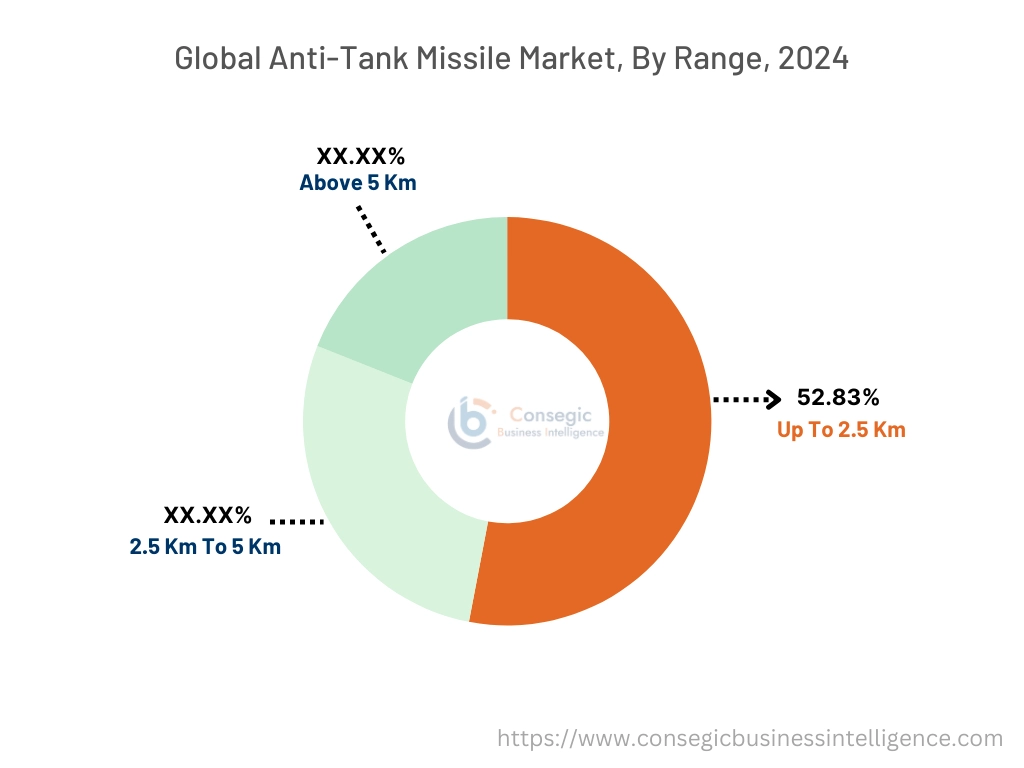
By Portability:
Based on portability, the market is bifurcated into man-portable and vehicle-mounted.
Trends in the Portability:
- The trend towards providing convenience and ease of deployment with ongoing technological advancement in the man-portable segment is fueling the market progress.
- The trend towards the rising adoption of armored vehicles in modern warfare is propelling the need for a vehicle-mounted anti-tank missile industry.
The man-portable accounted for the largest revenue share in the year 2024.
- The portability and advancement in lightweight design drive the market progress for the man portable segment.
- Further, the ability to operate efficiently during day and night as well as the ability to strike using a dual-mode seeker is propelling the market development.
- For instance, in April 2024, according to the Ministry of defence, India, DRDO & Indian Army successfully conducted a trial of a man-portable anti-tank guided missile weapon system at the Pokhran Field Firing Range, Rajasthan, India. Additionally, the system features MPATGM, a launcher, a target acquisition system, and a fire control unit.
- Thus, as per the analysis, the ability to operate efficiently with lightweight design and portability fuels the anti-tank missile market size.
The vehicle mounted is anticipated to register the fastest CAGR during the forecast period.
- The missile systems are easily attached to helicopters, drones, armored vehicles, and assault vehicles driving the market adoption in vehicle vehicle-mounted segment.
- Further, the missile system when mounted on a vehicle provides high mobility while operating under complicated terrain.
- Furthermore, the increased mobility and larger caliber drive the adoption of the vehicle-mounted anti-tank missile market.
- For instance, in March 2021, the Chinese People’s Liberation Army (PLA) launched a vehicle-mounted anti-tank missile. The missile features a larger caliber is highly mobile and runs in complicated terrain.
- Therefore, as per the market analysis, the ability to operate under complicated terrain is anticipated to boost the market during the forecast period.
By Platform:
Based on the platform, the market is segmented into land-based, Airborne Based, and Naval Based.
Trends in the Platform:
- The trend towards increasing focus on the development of missile systems that can be launched from multiple platforms including land, naval, and airborne.
- The technological advancement in guided missiles due to improved accuracy is boosting the need for land-based systems.
The land-based accounted for the largest revenue share in the year 2024.
- The missile launched from the ground or land is specially designed for striking and defeating ground-based targets such as armored tanks and armored vehicles, among others.
- Further, the increasing need for affordable, user-friendly design as well as the ability to eliminate armored vehicles on the battleground is driving the need for a land-based anti-tank missile market.
- For instance, Lockheed Martin Corporation has a weapon system called Javelin which is an anti-tank missile utilized in ground operation. The missile features improved visibility, improved safety, and defeat all known and projected threat armor, among others.
- Thus, according to the anti-tank missile market analysis, the increasing need for affordable, user-friendly design is driving the market progress.
The airborne base is anticipated to register the fastest CAGR during the forecast period.
- The rising adoption of unmanned aerial vehicles and others in the military and defense sector is fueling the market progress for the airborne-based segment.
- Moreover, the integration of cutting-edge thermal imaging sensors with systems attached to drones, helicopters, and others is boosting the market development.
- Further, the Russia-Ukraine war and Israeli military campaign against the Hamas terrorist group in Gaza are propelling the need for airborne-based anti-tank missile market development.
- Therefore, according to the anti-tank missile market analysis, the ongoing wars as well as the integration of innovative thermal imaging sensors are anticipated to boost the market during the forecast period.
Regional Analysis:
The regions covered are North America, Europe, Asia Pacific, the Middle East and Africa, and Latin America.
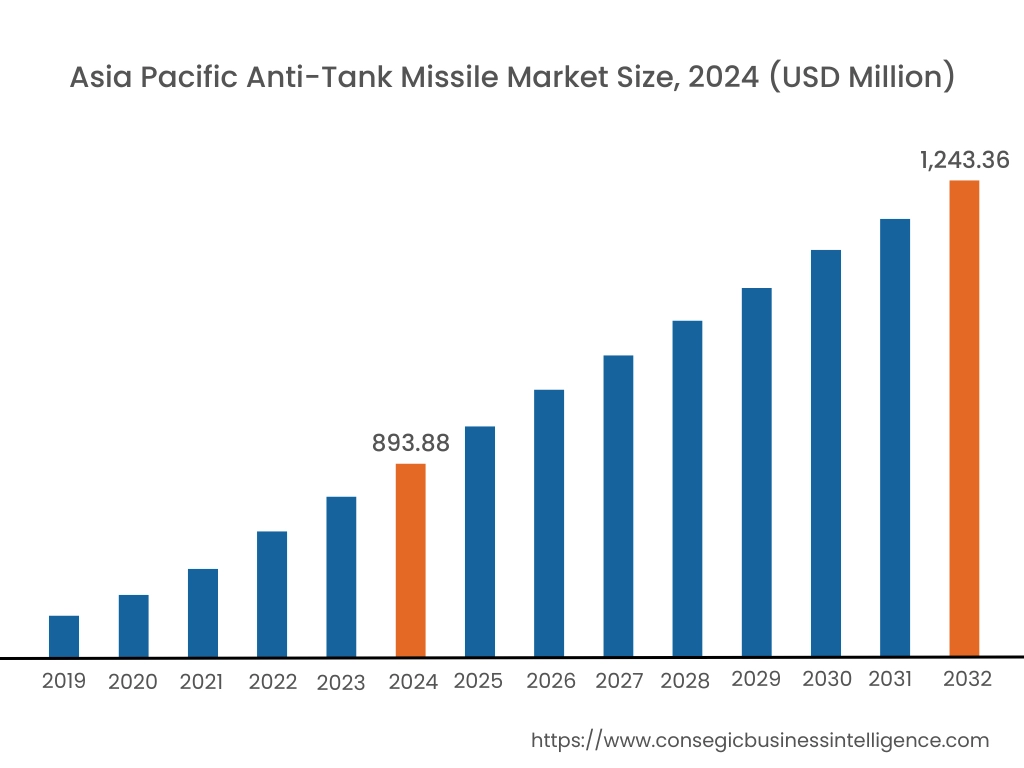
Asia Pacific region was valued at USD 893.88 Million in 2024. Moreover, it is projected to grow by USD 914.29 Million in 2025 and reach over USD 1,243.36 Million by 2032. Out of this, China accounted for the maximum revenue share of 35.1%. The market growth for anti-tank missiles is mainly driven by rising terrorism & border threats, geopolitical conflicts, and increased defense budgets. Additionally, the increasing trend of growing defense budget and rising need for advanced missile systems is projected to drive the market growth in the Asia pacific region during the forecast period.
- For instance, in September 2024, the White House announced USD 567 million in defense support for Taiwan, reflecting the U.S.'s commitment to bolstering the island's military amid escalating tensions with China.
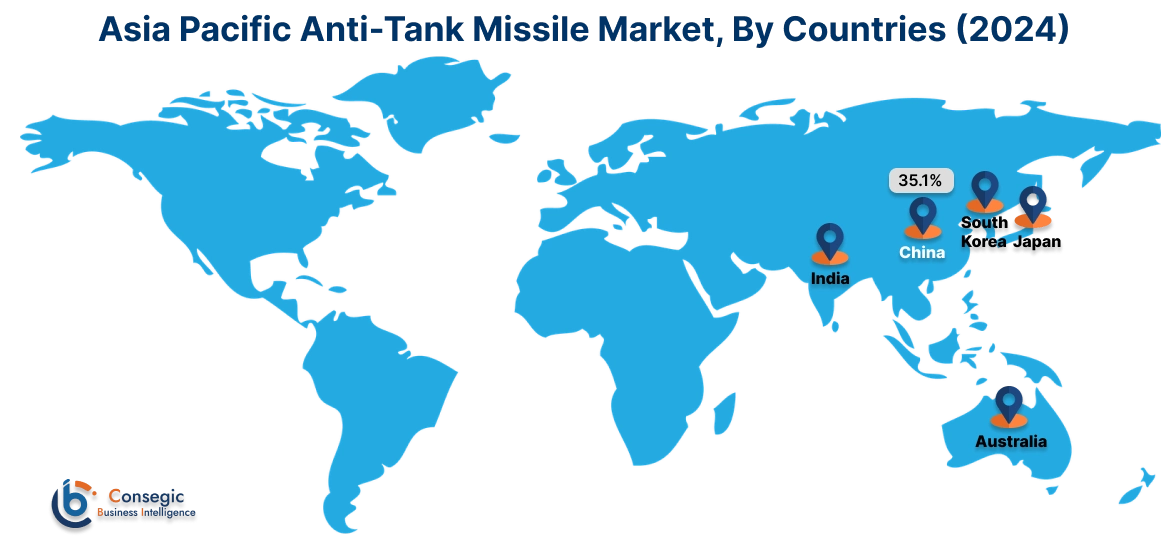
North America is estimated to reach over USD 1,408.67 Million by 2032 from a value of USD 1,079.14 Million in 2024 and is projected to grow by USD 1,097.90 Million in 2025. The North American region's growing investment in the modernization of weapons and missile systems offers lucrative growth prospects for the market. Additionally, geopolitical concerns play a key role in driving the market growth in the region.
- For instance, in 2024, KONGSBERG secured a multi-year contract with the US Navy to supply Naval Strike Missiles (NSM) to the Navy and Marine Corps. The contract shows the growing need for strike missiles across NATO and allied nations.
The regional trends analysis depicts that the increasing geopolitical conflicts such as the Russia-Ukraine war and the modernization of military forces are playing a key role in driving the Europe market.
Additionally, the primary factors driving the market in the Middle East and African region are increased military competition and growing confrontation between countries. Further, the rising need for long-range missile systems and increasing defense expenditure are paving the way for the progress of the market in the Latin America region.
Top Key Players and Market Share Insights:
The global anti-tank missile market is highly competitive with major players providing systems to the national and international markets. Key players are adopting several strategies in research and development (R&D), product innovation, and end-user launches to hold a strong position in the anti-tank missile industry. Key players in the anti-tank missile market include-
- Lockheed Martin Corporation (U.S.)
- General Dynamics Corporation (U.S.)
- Thales (France)
- Roketsan (Turkey)
- Hanwha Aerospace (South Korea)
- Kongsberg Gruppen (Norway)
- MBDA (France)
- Raytheon Technologies (U.S.)
- Denel Dynamics (South Africa)
- Rafael Advanced Defense Systems (Israel)
- BAE Systems PLC (UK)
Recent Industry Developments :
Strategic Partnerships and Agreements:
- In January 2024, Saab and MBDA signed an agreement for a strategic partnership to develop anti-tank and air defense systems. This collaboration aims to leverage the combined expertise of both companies in these crucial areas.
- In September 2024, the Dutch Ministry of Defense signed an agreement with Rafael Advanced Defense Systems to procure Spike LR2 missile systems. The procurement signifies a significant upgrade to the Dutch military's anti-tank capabilities, enhancing their ability to counter modern threats on the battlefield.
Market Expansion:
- In September 2024, Kongsberg Defence and Aerospace announced expansion of its US presence with a new missile production facility. The new facility will enhance Kongsberg's ability to supply the US military with its Naval Strike Missile and Joint Strike Missile.
Anti-Tank Missile Market Report Insights :
| Report Attributes | Report Details |
| Study Timeline | 2019-2032 |
| Market Size in 2032 | USD 4,122.53 Million |
| CAGR (2025-2032) | 3.8% |
| By Range |
|
| By Portability |
|
| By Platform |
|
| By Region |
|
| Key Players |
|
| North America | U.S. Canada Mexico |
| Europe | U.K. Germany France Spain Italy Russia Benelux Rest of Europe |
| APAC | China South Korea Japan India Australia ASEAN Rest of Asia-Pacific |
| Middle East and Africa | GCC Turkey South Africa Rest of MEA |
| LATAM | Brazil Argentina Chile Rest of LATAM |
| Report Coverage |
|
Key Questions Answered in the Report
How big is the anti-tank missile market? +
The Anti-Tank Missile Market is estimated to reach over USD 4,122.53 Million by 2032 from a value of USD 3,095.74 Million in 2024 and is projected to grow by USD 3,154.74 Million in 2025, growing at a CAGR of 3.8% from 2025 to 2032.
What specific segmentation details are covered in the anti-tank missile report? +
The anti-tank missile report includes specific segmentation details for range, portability, platform, and regions.
Which is the fastest segment anticipated to impact the market growth? +
In the anti-tank missile market, the vehicle-mounted is the fastest-growing segment during the forecast period due to the anti-tank missile systems when mounted on vehicles provide high mobility while operating under complicated terrain.
Who are the major players in the anti-tank missile market? +
The key participants in the anti-tank missile market are Lockheed Martin Corporation (U.S.), General Dynamics Corporation (U.S.), MBDA (France), Raytheon Technologies (U.S.), Denel Dynamics (South Africa), Rafael Advanced Defense Systems (Israel), BAE Systems PLC (UK), Thales (France), Roketsan (Turkey), Hanwha Aerospace (South Korea), Kongsberg Gruppen (Norway) and others.
What are the key trends in the anti-tank missile market? +
The anti-tank missile market is being shaped by several key trends including the trend towards providing convenience and ease of deployment with ongoing technological advancement in the man-portable segment as well as technological advancement in guided missiles due to improved accuracy and other key trends driving the market.
